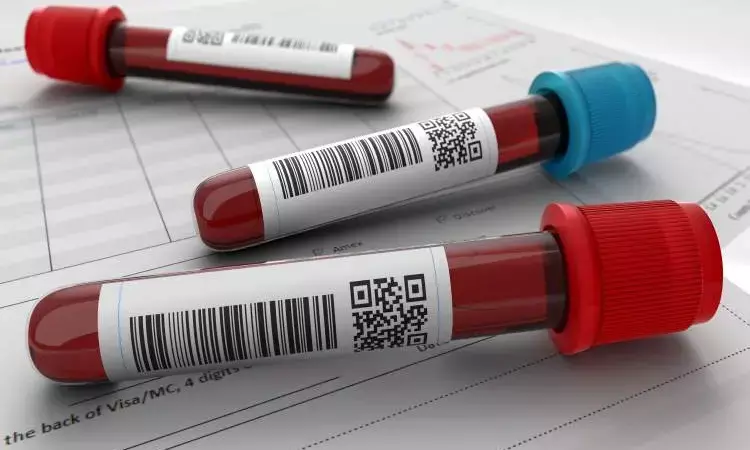- Home
- Medical news & Guidelines
- Anesthesiology
- Cardiology and CTVS
- Critical Care
- Dentistry
- Dermatology
- Diabetes and Endocrinology
- ENT
- Gastroenterology
- Medicine
- Nephrology
- Neurology
- Obstretics-Gynaecology
- Oncology
- Ophthalmology
- Orthopaedics
- Pediatrics-Neonatology
- Psychiatry
- Pulmonology
- Radiology
- Surgery
- Urology
- Laboratory Medicine
- Diet
- Nursing
- Paramedical
- Physiotherapy
- Health news
- Fact Check
- Bone Health Fact Check
- Brain Health Fact Check
- Cancer Related Fact Check
- Child Care Fact Check
- Dental and oral health fact check
- Diabetes and metabolic health fact check
- Diet and Nutrition Fact Check
- Eye and ENT Care Fact Check
- Fitness fact check
- Gut health fact check
- Heart health fact check
- Kidney health fact check
- Medical education fact check
- Men's health fact check
- Respiratory fact check
- Skin and hair care fact check
- Vaccine and Immunization fact check
- Women's health fact check
- AYUSH
- State News
- Andaman and Nicobar Islands
- Andhra Pradesh
- Arunachal Pradesh
- Assam
- Bihar
- Chandigarh
- Chattisgarh
- Dadra and Nagar Haveli
- Daman and Diu
- Delhi
- Goa
- Gujarat
- Haryana
- Himachal Pradesh
- Jammu & Kashmir
- Jharkhand
- Karnataka
- Kerala
- Ladakh
- Lakshadweep
- Madhya Pradesh
- Maharashtra
- Manipur
- Meghalaya
- Mizoram
- Nagaland
- Odisha
- Puducherry
- Punjab
- Rajasthan
- Sikkim
- Tamil Nadu
- Telangana
- Tripura
- Uttar Pradesh
- Uttrakhand
- West Bengal
- Medical Education
- Industry
Study Finds a Novel Prognostic Marker for Epidermal Necrolysis

Epidermal necrolysis is a severe cutaneous adverse reaction in which severe systemic inflammation results in extensive epithelial keratinocyte necrosis. In a recent study, researchers have found a novel inflammatory biomarker that improves prognostication of epidermal necrolysis. The study findings were published in the JAMA Dermatology on December 22, 2021.
The Toxic Epidermal Necrolysis Severity Score (SCORTEN) is the most widely used prognostic score for epidermal necrolysis. However, recent studies have shown that SCORTEN overestimated mortality. Identifying independent prognostic markers helps to more accurately stratify risk. Therefore, Dr Haur Yueh Lee and his team conducted a study to evaluate the association between novel inflammatory markers and in-hospital mortality in patients with epidermal necrolysis to study the incremental prognostic value of these markers in combination with SCORTEN.
They conducted the retrospective study, over 17 years from 2003 to 2019 and included 192 patients with Stevens-Johnson syndrome/toxic epidermal necrolysis (median age 56; 59% women), of whom 43 (22.4%) did not survive to discharge. The major outcome assessed was the in-hospital mortality rate. They used the area under the receiver operating characteristic curve (AUC) and calibration plot to assess the discrimination and calibration of risk score. They evaluated the incremental prognostic value of these markers by comparing the AUC between the old and new risk scores and the use of net reclassification improvement and integrated discrimination improvement.
Key findings of the study:
- Among various novel inflammatory markers easily obtained from a complete blood count, such as neutrophil to lymphocyte ratio, platelet to lymphocyte ratio, and lymphocyte to monocyte ratio, the researchers observed, only red cell distribution width to hemoglobin ratio (RDW/Hb) was significant in predicting in-hospital mortality (odds ratio, 3.55) after adjustment for SCORTEN.
- They noted that applying RDW/Hb in 4 risk groups showed similar discrimination to SCORTEN (AUC: RDW/Hb in 4 groups, 0.76, vs SCORTEN, 0.78).
- When RDW/Hb was added to SCORTEN, they found that the composite score Re-SCORTEN showed significantly better discrimination than SCORTEN alone (AUC: Re-SCORTEN, 0.83, vs SCORTEN, 0.78).
- They noted that the overall net reclassification improvement was 0.94, and the integrated discrimination improvement, 0.06.
- They also noted that the Re-SCORTEN showed good calibration based on the calibration plot.
The authors concluded, "In this cohort of patients, RDW/Hb, an inexpensive and readily available marker, showed similar predictive accuracy with SCORTEN. Furthermore, when used in combination with SCORTEN, it also helped augment prognostic ability."
For further information:
Medical Dialogues Bureau consists of a team of passionate medical/scientific writers, led by doctors and healthcare researchers. Our team efforts to bring you updated and timely news about the important happenings of the medical and healthcare sector. Our editorial team can be reached at editorial@medicaldialogues.in.
Dr Kamal Kant Kohli-MBBS, DTCD- a chest specialist with more than 30 years of practice and a flair for writing clinical articles, Dr Kamal Kant Kohli joined Medical Dialogues as a Chief Editor of Medical News. Besides writing articles, as an editor, he proofreads and verifies all the medical content published on Medical Dialogues including those coming from journals, studies,medical conferences,guidelines etc. Email: drkohli@medicaldialogues.in. Contact no. 011-43720751


